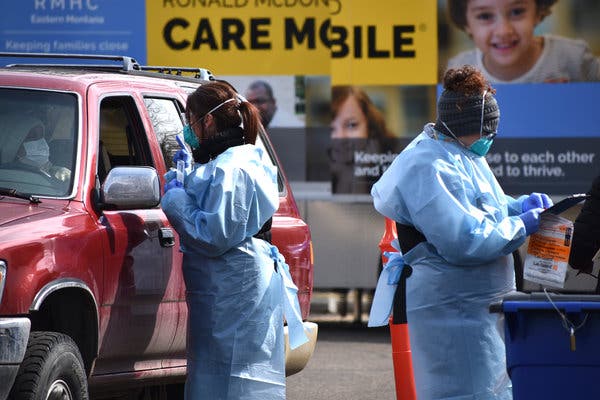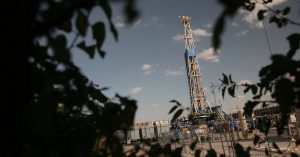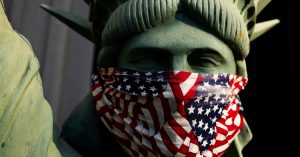Guiding a state like Montana through a pandemic is difficult because Montana is a complicated state in a precarious position. Its significant Indigenous population is spread across seven reservations whose resources are spread thin even in non-pandemic times. When bidding on critical resources, the state can’t compete with the bigger needs of coastal states like New York or California.
As a tourism hub and second-home escape for the wealthy, Montana is vulnerable to increased outbreaks brought in from those looking to flee crowded cities. Many of the state’s rural counties have health care infrastructure that would easily be overwhelmed if hit by a full-fledged Covid-19 outbreak. Testing capacity is stretched thin and should supply chains fall down — even for a day — the state could find itself unable to catch up with the virus.
Given the absence of leadership from the federal government, the job of keeping pace with the coronavirus is largely up to Montana’s governor, Steve Bullock, a Democrat. So far, Mr. Bullock’s actions have been decisive. Behind closed doors, he’s tangled with President Trump, pushing for resources. On March 13, Montana announced its first four Covid-19 cases. Two days later, the state issued an executive order to close all public schools, along with suspending nursing home visits and enacting a stay at home order. Compared to other states, Mr. Bullock’s decision came quite early in the state’s outbreak — New York City, for example, announced it would close its public schools on March 15, after 329 confirmed Covid-19 cases and five deaths.
People frequently typecast Montana as a red state. In reality, it’s a state that votes based on the candidate over the party. Democrats win by very slim margins here. And Mr. Bullock — looking to a Senate run later this year — has to walk a fine line between criticizing the president and getting what he needs for his state. And yet the governor has taken the relatively progressive steps of issuing travel directories with 14-day quarantines and airport screenings, expanding unemployment services and, unlike states like Wisconsin, instituting an all-mail election for Montana’s June primaries.
That means Montana has remained ahead of many states with larger outbreaks, including those with Republican governors who waited to act and now face climbing case rates. As of this writing Montana has 354 Covid-19 cases and six deaths. Hospital systems aren’t yet overwhelmed and some projection models suggest cautious optimism, alongside intense pressure on Mr. Bullock to keep the outbreak in check.
As a relatively new Montana resident, I’ve been impressed by the governor’s decisive action. Late last week I called up Mr. Bullock to get a sense what it’s like to preside over a state in a once-in-a-century crisis. Below is an edited transcript of our conversation.
I want to ask about the leaked audio of a governors’ call with the president last month. You were vocal about the testing shortage and it was pretty shocking to hear the president suggest he wasn’t aware that testing was a problem. Are you seeing that this is still the attitude of the administration on this? Is there still a disconnect between state governors and the administration?
Whether you are in Montana or Louisiana, the governors are damn concerned about whether we can get the testing supplies or P.P.E. [personal protective equipment] The idea pushed down from the administration is that this must be locally executed, state-managed and federally supported. But governors need that federal support if we’re going to manage this. And I’ve had calls with incredible people in the federal government working damn hard to get me what I need.
But if this really is supposed to be state-managed and federally supported, then we need not just on-the-ground supplies and materials, but also to make sure statements coming from the administration don’t undercut what we do. I’m pleased the administration is now saying distancing ought to run through at least the end of April. But the same time I was putting out Montana’s stay-at-home directive, the very same week the administration was saying that the cure was worse than problem and that things should be opened up by Easter.
Right now, what’s the one thing the administration could be doing directly for you that they aren’t?
Make it so that I’m not spending as much time trying to make sure I have the supplies to address this pandemic. We’re doing Project Airbridge [an initiative to get medical supplies from China to the U.S.] now. But 80 percent of that is just going into the private market. We haven’t fixed supply chains so that governors aren’t competing against governors to try to get things. And it’s unclear whether breakdowns are the suppliers’ excuse or, in reality, I’m being pre-empted by federal government. I’m rooting for the federal government to succeed here but if we as a state aren’t seeing actions taken that need to be done we’re not going slow this thing. We need federal support.
Every state is going to have its own challenges. You’re working with tribal leaders and trying to make sure remote counties have resources ready. What other challenges are you experiencing right now that are unique to Montana?
In rural counties it’s making sure when they say, “Oh, we don’t have any cases” that we try to control the actual contagion and we also manage the social contagion. That means making sure everyone takes it equally seriously because a smaller community could easily be overwhelmed. We did something with bridge financing recently for rural, critical access hospitals because if we lose one of those it makes things so much harder along the way.
[Author’s note: The financing would provide low-cost funding to allow facilities to purchase supplies, pay staff, and remain open, though there are concerns “it might not arrive quickly enough to keep some hospitals afloat.”]
Now, there are upsides, I think, to our state. Even before this all happened I probably knew the names of 70 percent of our hospital administrators. It helps that in non-crisis times we’re all so close. Montanans expect to know the governor and I expect to know them.
We’re all helping each other out locally — I’ve gotten as many N95 masks from North Dakota as I have from than from strategic national stockpile so far [Governor Bullock’s office clarified on Monday that, over the weekend, Montana received only 10,000 of the 80,000 N95 masks from the national stockpile and currently the state has received more masks from North Dakota than it has from the national stockpile.]
One challenge I’m noticing is how to manage the influx of out-of-state visitors and residents coming into the state. It seems especially tricky for those who have second homes and pay taxes in the state.
Listen, I love to show off our public lands. I think the tension does exist, though. Let’s take it back a couple of weeks where the National Park Service says, “Come to parks, we’re not going to charge entrance fees to Yellowstone or Glacier.” Now we have the new challenge of people coming to get away from it all and so they come to Montana and local supplies are strained at the same time we’re trying to curb or limit the spread. Worse yet, those gateway communities are the smaller towns where the health care system could face serious challenges.
[Author’s note: Several parks have closed recently, including Yellowstone and Glacier.]
We welcome those second-home owners but I’m asking them to make sure if they do come here that they quarantine for two weeks because we don’t want other states’ problems to become ours. If you flew into Bozeman this afternoon from New York we’re going to temperature check you immediately when you get off the plane and say, “You’re now in Montana so now we expect you to quarantine for two weeks and then to follow the directives we put out.” None of that is to say we’re afraid of visitors or that we’re walling off the state. It’s saying, “If you are visiting Montana you have to take it as seriously as we do. And that’s very seriously.”
Some states — Idaho, Georgia and Florida, to name a few — have been slow to act. Are you and others putting pressure on them to be more decisive when it comes to the virus?
Each governor has to figure out how to best manage this to the best of their judgment. When I decided on our stay at home order, I reached out to a number of governors who put it in a few days before me for advice on how to implement. But I don’t second guess what others are doing; that’s not how I do it.
The Times is committed to publishing a diversity of letters to the editor. We’d like to hear what you think about this or any of our articles. Here are some tips. And here’s our email:[email protected].
Follow The New York Times Opinion section on Facebook, Twitter (@NYTopinion) and Instagram.



















